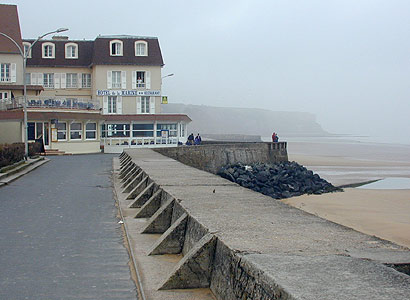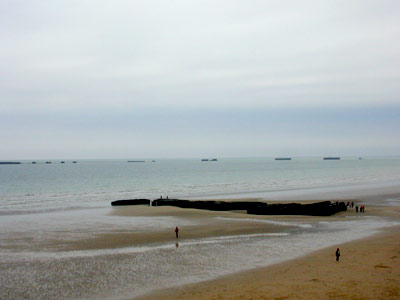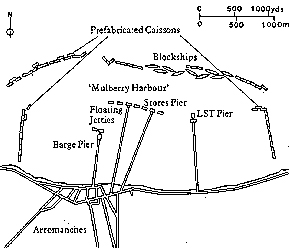From Caen we rode the bus to Arromanches, where we would stay for two nights at a hotel right on the seawall. We had dinner both evenings in the dining room facing in this direction.


The concrete structures on the beach are part of the remains of a "mulberry", one of 146 concrete caissons which were made in England, towed across the English channel(which the French call "la Manche" or sleeve), and sunk in place to form a breakwater for an artificial harbor. Many can still be seen in the distance in this picture.
The Allies felt it was necessary to build an artificial harbor since the existing ports of Le Havre and Cherbourg would be well defended by the Germans. This harbor was named Port Winston since Winston Churchill came up with the idea.
There are no remains left of the piers which were also towed there and used to allow boats to come into this artificial harbor and unload. This is illustrated in the following drawing.

Here we can see the three areas where the caissons were placed. A number of old ships were also sailed across the channel and sunk to form more of the breakwater. Piers which would rise and fall with the tide were also built in England, towed to this location and placed here. To connect the piers with the shore there were floating roadways made of small concrete pontoons linked by metal bridges; each was almost 4,000 ft long. This was all in place by June 10, allowing the Allies to land over 9,000 tons of equipment a day.
A similar harbor was built at Omaha Beach, but a huge storm on June 19 wrecked it and it was not used.
The Musée Du Débarquement has a movie describing the artificial harbor, as well as models of the piers and breakwater and many artifacts of the landing here.

Our tour was in Arromanches a few weeks before the 60th anniversary of D-Day. A poster outside the museum expresses the thanks of the French people to the veterans who would be visiting for the celebration.
Continue to see more of the D-Day Beaches.